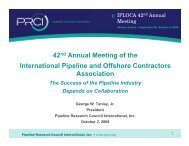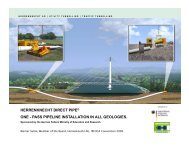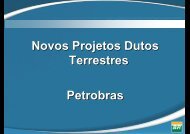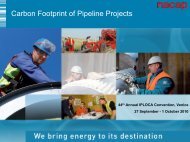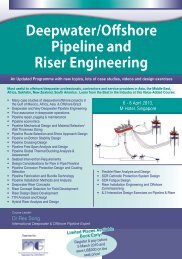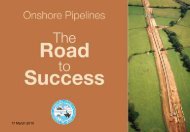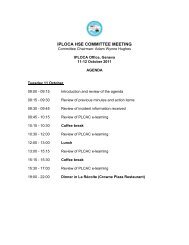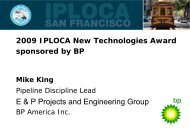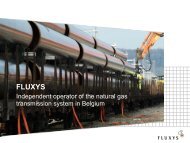EPRG-PRCI-APIA 17th JOINT TECHNICAL MEETING ON ... - Iploca
EPRG-PRCI-APIA 17th JOINT TECHNICAL MEETING ON ... - Iploca
EPRG-PRCI-APIA 17th JOINT TECHNICAL MEETING ON ... - Iploca
You also want an ePaper? Increase the reach of your titles
YUMPU automatically turns print PDFs into web optimized ePapers that Google loves.
Workshop 4: Welding and weld inspection (including installation)<br />
<strong>PRCI</strong> Project MATH-1, JTM Paper 14: Welding of high strength steel pipelines<br />
The aim of the project is to provide a fundamental understanding of the factors that affect<br />
the mechanical properties of welds in high strength (X100) steel pipelines; particularly weld<br />
design, testing and assessment procedures.<br />
<strong>PRCI</strong> Project CNST-2-1: Modernizing onshore pipeline construction<br />
This project will consider the entire onshore pipeline construction process and will identify<br />
new/existing technologies with the potential to achieve significant reductions in the time/cost<br />
of construction. The work will identify the most promising opportunities to achieve step<br />
changes in pipeline construction efficiency.<br />
<strong>APIA</strong> Project 1.1.1: In-service welding on thin-walled pipelines<br />
Existing methodologies for welding on in service pipelines were restricted to thicknesses<br />
above some of the common thicknesses encountered on Australian pipelines. New burn<br />
through prediction and HAZ hardness modelling software was developed targeting<br />
thicknesses as low as 3.2mm and grades up to X80. The models were confirmed by<br />
experiment. The project was conducted in collaboration with <strong>PRCI</strong>.<br />
<strong>APIA</strong> Project 1.1.2: Understanding hydrostatic testing<br />
Increasing the design factor to 80% SMYS whilst retaining the hydrostatic test factor of 1.25<br />
means that all affected pipelines must be tested to above nameplate strength. Coupled with<br />
this the yield/tensile ratio in high strength pipe can be very high, especially when measured<br />
using tests such as the ring expansion test and when the pipe is coated using processes<br />
such as FBE which cause strain ageing. These circumstances led to concerns that the<br />
available ductility could be diminished or exceeded in volume controlled hydrostatic tests.<br />
A program of testing was undertaken to establish the real strength and ductility of pipe as<br />
manufactured and after coating, and this was supplemented by full scale burst testing. The<br />
behaviour of hydrostatic test sections comprising known strength populations in different<br />
hydraulic gradients was modelled and software was developed that could predict test section<br />
behaviour. The project led to a better awareness of the effect of coating on strength and<br />
toughness properties and of the need to consider this effect in design and specification.<br />
<strong>APIA</strong> Project 1.1.4: Pipeline hydrostatic testing: pressure/temperature correlation<br />
The uncertainty of measurement of temperature affects the accuracy of leak detection in<br />
hydrostatic leak testing. The cost of hydrotesting is also affected by the time taken for<br />
stabilisation of the temperature of the fill water which causes delays before testing can be<br />
undertaken<br />
The project involved a study of the thermal behaviour of a pipeline during filling and<br />
pressurisation and a model was developed to determine longitudinal variations in<br />
temperature. A series of charts were developed that can be used to predict optimum<br />
stabilisation times depending upon starting conditions. Recommendations were also made<br />
for changes to the hydrostatic testing standard including allowing the use of a wider range of<br />
testing fluids for leak detection<br />
<strong>APIA</strong> Project 1.2.6, JTM Paper 13: Boron in EXX10 weld metal<br />
Although there is no published research and no manufacturer product data information in the<br />
public domain describing the use of boron as an alloying element it has come to the notice of<br />
the <strong>APIA</strong>-RSC that some manufacturers are routinely adding B to some electrodes. B is the<br />
most potent and potentially the most fickle of all the alloying elements that can be added to<br />
steel. It is reasonable to expect that it can have a major impact on HACC, and that the<br />
degree of uptake into the weld metal, and hence the weld metal properties, will be affected<br />
by process conditions such as arc length and coating moisture<br />
The project seeks to determine whether boron is being used in commercial cellulosic<br />
electrodes used for welding pipelines, and if so, how the welding conditions affect the pickup<br />
of boron from the consumable into the weld metal.



